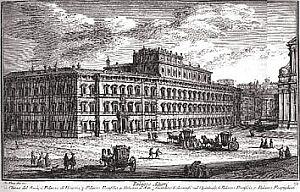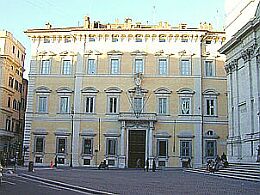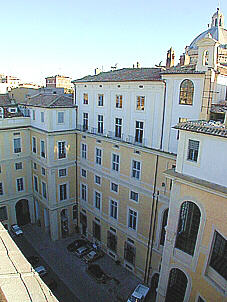"Rome Skies" aka "Rome views":
T
he palace
The noble Palazzo was built
in the 16th century, and is one of the most famous and
prestigious of Rome. It is ranked among the national
and historical monuments by the Ministry of Cultural
Resources. The area on which it is built is higher than
the rest of the centre, as it is close to Capitol Hill.
The palace was built by Antonio De Rossi, under the
auspices of Pope Clemens X. |
|
|
|
Vasi's 17th century drawing
|
The entrance in Piazza del Gesu' |
Just in front of the palace you find the very famous Jesus Church ("Chiesa del Gesu' "), the main church of the Jesuite order (it is shown in the lower part of this page). In addition, around the palace you find other very famous palaces: Palazzo Cenci-Bolognetti (in front), Palazzo Grazioli (to its side), Palazzo Venezia (former embassy of the Republic of Venice, then of the Austrian Empire, then seat of Mussolini's fascist government, and currently seat of the Ministry of Cultural Resources), and finally the Palazzo Doria Pamphili.
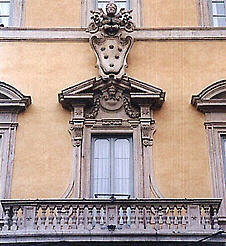
|
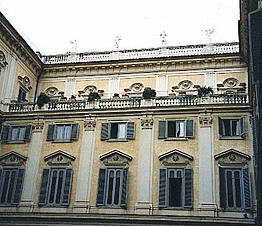 |
Clemens X coats of arm |
Palace: the inner courtyard |
The coat of arms and the heraldic symbols of the Pope are still visible in the facade, and the stars - symbol of the noble family - can be found everywhere. The inner court is most mannerly. You find columns, sumptuous windows, terraces, and statues in the parapet.
|
The palace has two concierges with portiers dressed
elegantly, and also a second court, more spacious,
including a private parking space. Only a few aristocrats
or wealthy families live in the building. You find also a few discrete offices of the managers of the Italian
Banking Society. There are elevators in each section.
The second court as mentioned is larger, and it
has its own separate entrance (from Via degli Astalli).
It includes a large private parking space, reserved
exclusely to those living in the palace.
|
|
The second internal court of the palace |
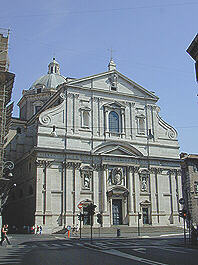
The Chiesa del Gesu' (Jesus Church)
|
The Palazzo faces the square
Piazza del Gesu', including as mentioned the splendid
Jesus Church (Chiesa del Gesu'), built between 1568
and 1578.
It is the main church of the Jesuit order, which became
the model of Counter-Reformation churches in Europe.
The facade is by Giacomo della Porta. The interior is
by Vignola, and it is exceptionally rich, with sumptuous
details in coloured marble and lapis lazuli.
Perhaps the major masterpiece is the fresco in the vault
of the nave, the "Triumph of the name of Jesus".
The author is Giovanni Battista Gaulli, also called
Baciccia, contemporary of Bernini (17th century), and
having his exuberant style. Also the Chapel of St. Ignatius
of Loyola by Andrea Pozzo (1696-1700) is renowned for
its opulence. |
|

